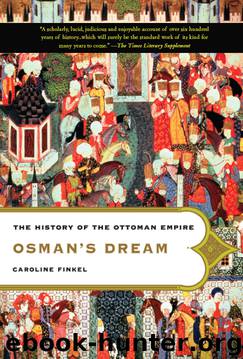Osman's Dream by Caroline Finkel

Author:Caroline Finkel
Language: eng
Format: epub, mobi
ISBN: 9780465008506
Publisher: Basic Books
Published: 2017-06-21T16:00:00+00:00
But the ‘Tulip Age’ was not only about pleasure. The sacred complement to the ostentatious banquets, audiences and progresses of Ahmed III’s reign were the visits he and his retinue of state dignitaries paid to the chamber housing the sacred mantle of the Prophet. Before the eighteenth century, visits to the mantle had been regular only at the accession of a new sultan; under Sultan Ahmed visiting the mantle became an elaborate state ceremony that took place annually on 15 Ramadan, the full moon on the middle day of the holiest month in the Islamic calendar. The previous day the Sultan would take part in the ritual cleaning of the chamber and in preparing the mantle for display. Contemporary ‘Books of Ceremonies’ give precise details of the ritual – who was to participate, with their order of precedence sketched in diagrammatic fashion, what they must wear, and the prayers to be performed.94
Another opportunity for Sultan Ahmed to remind his subjects that religion was an essential component of Ottoman dynastic life presented itself on the occasion of the ritual ceremony symbolizing the religious instruction of his young sons, which took place with great pomp shortly after their spectacular circumcision feast in 1720. The younger princes – Mehmed, Mustafa and Bayezid – were only three and four years old when the Sultan and the highest officials of state, both secular and religious, attended the ceremony in the Pearl Pavilion on the coast below Topkapı Palace.95 The Sultan’s concern for his people was demonstrated when five thousand poor boys were circumcised at the same time as his sons.96
In another gesture underlining the attachment of those in power to the sacred calendar, Damad İbrahim Pasha gave a more extravagant form to the feasts which traditionally marked the end of the month of Ramadan. Soon after he came to the grand vezirate, in 1721, he held a feast at Eyüp, he and his retinue returning to Istanbul afterwards with great pomp. Such feasts became more splendid as time went by,97 perpetuated throughout the century by Mahmud I and his successors as a means of impressing upon the court and people the sultan’s piety and continuing relevance as head of state.*
If the clerical profession had their doubts about the comportment of court society, they were nevertheless easily co-opted. Lectures were held in the presence of Damad İbrahim Pasha during Ramadan at which leading clerics engaged in learned disputation on a passage from the Koran or the Traditions of the Prophet. The text to be debated was carefully chosen: among the Koranic passages discussed during the 1720s were those concerning ‘Victory’ – an appropriate topic in the context of the Iranian campaigns that began in 1722.98
As the identification of the clerical profession with the goals of the dynasty grew closer it was manipulated to enhance the legitimacy of the Sultan, and develop a coterie of allies. The role of the clerical profession also changed in more subtle ways as it became increasingly more of a ‘closed shop’.
Download
This site does not store any files on its server. We only index and link to content provided by other sites. Please contact the content providers to delete copyright contents if any and email us, we'll remove relevant links or contents immediately.
| Africa | Americas |
| Arctic & Antarctica | Asia |
| Australia & Oceania | Europe |
| Middle East | Russia |
| United States | World |
| Ancient Civilizations | Military |
| Historical Study & Educational Resources |
Empire of the Sikhs by Patwant Singh(22766)
The Wind in My Hair by Masih Alinejad(4843)
The Templars by Dan Jones(4558)
Rise and Kill First by Ronen Bergman(4545)
The Rape of Nanking by Iris Chang(4023)
12 Strong by Doug Stanton(3419)
Blood and Sand by Alex Von Tunzelmann(3055)
The History of Jihad: From Muhammad to ISIS by Spencer Robert(2505)
Babylon's Ark by Lawrence Anthony(2431)
The Turkish Psychedelic Explosion by Daniel Spicer(2245)
Gideon's Spies: The Secret History of the Mossad by Gordon Thomas(2235)
No Room for Small Dreams by Shimon Peres(2235)
Inside the Middle East by Avi Melamed(2230)
Arabs by Eugene Rogan(2193)
The First Muslim The Story of Muhammad by Lesley Hazleton(2154)
Bus on Jaffa Road by Mike Kelly(2035)
Come, Tell Me How You Live by Mallowan Agatha Christie(2025)
Kabul 1841-42: Battle Story by Edmund Yorke(1921)
1453 by Roger Crowley(1880)
